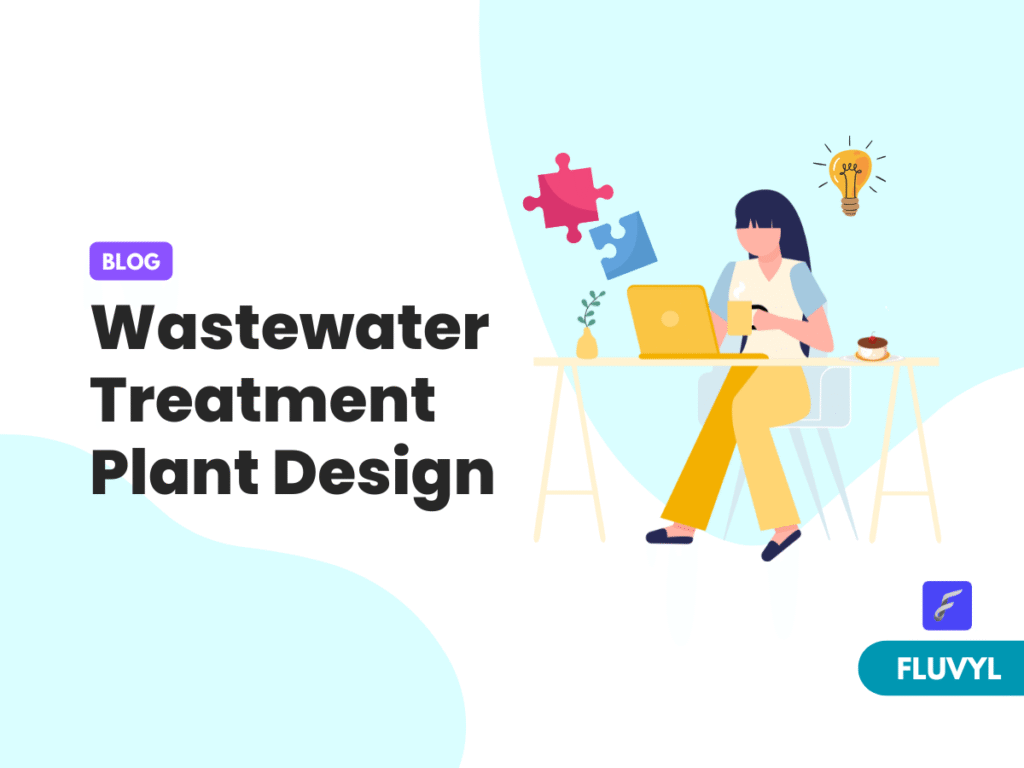Wastewater Treatment Plant Design: A Comprehensive Guide

By Fluvyl, updated Apr 17, 2025

Synopsis
Designing a wastewater treatment plant (WWTP) is a complex yet essential process that ensures the effective removal of contaminants from domestic, industrial, and municipal wastewater. This blog offers a detailed guide on wastewater treatment plant design, covering all crucial aspects from understanding influent characteristics to final discharge standards, layout planning, and equipment selection. It includes design criteria, flow diagrams, tables, and modern design considerations to help engineers, students, and environmental professionals make informed decisions.
The wastewater treatment plant design process involves the planning and sizing of treatment facilities to meet local environmental regulations and sustainability goals. It plays a vital role in safeguarding water resources, public health, and the ecosystem.
With rising urbanization and industrial growth, effective wastewater treatment plant design is now more critical than ever. A well-designed WWTP ensures the removal of physical, chemical, and biological pollutants, allowing safe discharge or reuse of water.
Objectives of Wastewater Treatment Plant Design
The main objectives are:
- Achieve desired effluent quality.
- Ensure cost-effective operation.
- Maximize treatment efficiency.
- Ensure safety and sustainability.
- Minimize land and energy use.
Key Factors Affecting Design
Several factors influence the wastewater treatment plant design:
| Factor | Impact on Design |
|---|---|
| Influent flow rate | Affects unit sizing, retention times |
| Influent characteristics | Determines treatment processes required (e.g., BOD, TSS, pH, oil & grease, etc.) |
| Effluent standards | Influences technology selection and sludge handling |
| Land availability | Determines layout and compact vs. conventional processes |
| Local climate | Impacts biological processes, aeration, and evaporation |
Preliminary Design Considerations
Before diving into unit sizing and process design, it’s essential to gather data and set design criteria:
Population Forecasting
Estimating future population is crucial for planning the capacity of the WWTP.
Example: Arithmetic Increase Method
| Year | Population |
|---|---|
| 2020 | 100,000 |
| 2030 | 120,000 |
| 2040 | 140,000 |
Flow Estimation
Daily flow is estimated based on per capita consumption.
Formula:
Q = P × q
Where:
Q = Flow (L/day)
P = Population
q = Per capita water consumption (L/person/day)
Components of Wastewater Treatment Plant Design
The major components include:
A. Preliminary Treatment
- Screens (removes large debris)
- Grit chambers (removes sand/grit)
- Flow equalization tanks
B. Primary Treatment
Sedimentation tanks to remove settleable solids.
C. Secondary Treatment
Biological treatment (Activated sludge, SBR, MBBR, etc.)
D. Tertiary Treatment
Advanced polishing steps (filtration, UV, chlorination, etc.)
E. Sludge Management
Thickening, digestion, dewatering, and safe disposal.
Design Parameters and Calculations
| Parameter | Standard Value/Range |
|---|---|
| BOD (influent) | 200 – 400 mg/L |
| BOD (effluent target) | < 30 mg/L |
| Detention time (Primary) | 2 – 3 hours |
| MLSS in aeration tank | 2000 – 4000 mg/L |
| Sludge Volume Index (SVI) | 50 – 150 mL/g |
| Sludge Retention Time (SRT) | 5 – 15 days |
Example: Aeration Tank Volume Calculation
Formula:
V = (Q × BOD) / (MLSS × Y × θc)
Where:
- Q = flow rate
- BOD = Biological Oxygen Demand
- MLSS = Mixed Liquor Suspended Solids
- Y = Yield coefficient
- θc = Mean Cell Residence Time
Sample WWTP Layout Plan
| Zone | Unit |
|---|---|
| Inlet Zone | Bar screen, grit chamber |
| Primary Zone | Sedimentation tank |
| Biological Zone | Aeration tank, secondary clarifier |
| Tertiary Zone | Sand filters, UV disinfection |
| Sludge Handling Zone | Digester, sludge drying beds |
Case Study: Small-Scale WWTP Design
Let’s consider a design for a 10,000-person town.
Design Assumptions:
- Per capita water usage: 135 L/day
- BOD: 300 mg/L
- Effluent standard BOD: < 30 mg/L
Step 1: Flow Estimation
Q = 10,000 × 135 = 1,350,000 L/day = 1.35 MLD
Step 2: Primary Sedimentation Tank
Detention time = 2 hrs
Volume = Q × t = (1.35 × 10^6) × (2/24) = 112,500 L = 112.5 m³
Step 3: Aeration Tank
MLSS = 3000 mg/L
SRT = 10 days
Y = 0.6
Volume = (1.35 × 300) / (3000 × 0.6 × 10) ≈ 22.5 m³
Common Challenges in Wastewater Treatment Plant Design
| Challenge | Mitigation |
|---|---|
| Influent variability | Include equalization tank |
| High energy costs | Use energy-efficient blowers, renewable sources |
| Sludge overproduction | Optimize biological process, SRT control |
| Land constraints | Use compact technologies (MBBR, SBR) |
| Odor issues | Proper sludge handling and aeration |
Modern Trends and Innovations
A. Smart Monitoring Systems
- IoT sensors to monitor BOD, pH, turbidity
- Real-time alerts and predictive maintenance
B. Energy Positive WWTP
- Anaerobic digesters for biogas
- Energy recovery from sludge
C. Nature-Based Solutions
- Constructed wetlands
- Green WWTP landscapes
D. Modular WWTP Designs
- Prefabricated units for rapid deployment
- These innovations are changing how wastewater treatment plant design is approached—shifting toward sustainability, automation, and resilience.
Conclusion
A robust wastewater treatment plant design is the foundation of efficient and sustainable wastewater management. By considering local needs, population projections, influent characteristics, and future expansion, engineers can build treatment plants that serve communities effectively.
This comprehensive guide to wastewater treatment plant design covered all the essential elements—from influent analysis to unit sizing and modern innovations. Whether you are a student, professional, or enthusiast, understanding these principles will give you a strong base for designing or evaluating treatment systems.
